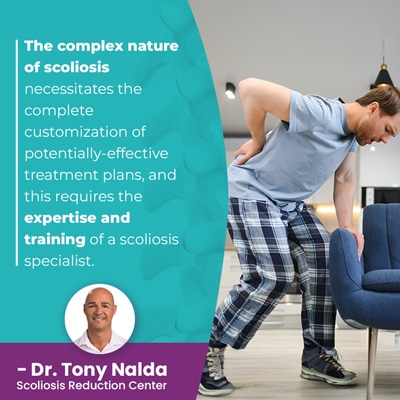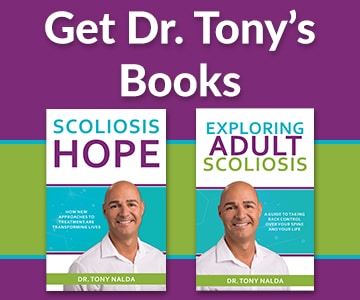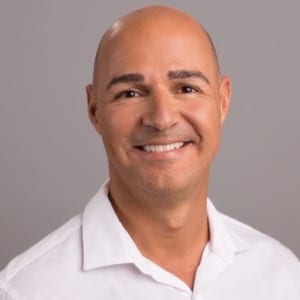Top 10 Questions Answered by a Scoliosis Chiropractor

A scoliosis chiropractor understands how scoliosis affects the spine, its surroundings, and the entire body. A spine that's misaligned due to scoliosis can cause effects felt throughout the body. While a general chiropractor can help maintain overall spinal health and flexibility, when it comes to corrective treatment results, the condition's complexities necessitate specific training.
There is an important distinction to be made between a general chiropractor and a scoliosis-specific chiropractor. A scoliosis chiropractor has specific training and certifications to craft and customize scoliosis treatment plans while general chiropractic treatment addresses symptoms.
It's important for scoliosis patients to be comfortable with their treatment provider and fully understand their approach; following are some helpful questions to ask a potential scoliosis chiropractor.
Scoliosis Should Be Taken Seriously
As a progressive spinal condition that causes the spine to bend and twist unnaturally, scoliosis should always be taken seriously.
Taking scoliosis seriously involves understanding the necessity of treatment, and with close to seven million people diagnosed with the condition in the United States alone, it's highly prevalent and warrants awareness.
Taking scoliosis treatment seriously also involves being aware of the different treatment options available and understanding their differences.
How a diagnosis of scoliosis is responded to with treatment can shape the spine's future health and function.
Understanding Different Treatment Approaches
There are two main approaches to treating scoliosis: with or without surgery.
Traditional scoliosis treatment funnels patients towards a surgical response because it doesn't have a strategy for addressing scoliosis while mild and is more about responding when conditions become severe, but there is a lot that can be done in the time it can take for mild scoliosis to become severe.
Spinal fusion surgery is an option for severe cases, but in terms of long-term spinal health, the less invasive treatment is, the better, and conservative treatment is aligned with the spine's movement-based design.
The biggest benefit of successful conservative treatment is that it means avoiding the potential side effects and complications of living with a fused spine, and once a spine is fused, it's fused for life; there is no going back or reversing treatment.
Chiropractic-centered treatment is proactive so is started immediately following a diagnosis. There are never treatment guarantees, but there is a direct link between early detection, intervention, and treatment success.
Conservative non-surgical treatment is chiropractic-centered, so don't be afraid to ask a potential scoliosis chiropractor the following 10 questions.
1) Is scoliosis your specialty?
There's a big difference between getting general treatment for scoliosis and getting scoliosis-specific treatment.
 The complex nature of scoliosis necessitates the complete customization of potentially-effective treatment plans, and this requires the expertise and training of a scoliosis specialist.
The complex nature of scoliosis necessitates the complete customization of potentially-effective treatment plans, and this requires the expertise and training of a scoliosis specialist.
A general chiropractor can help keep the spine flexible and strong, but this is more about overall health than corrective treatment results; a scoliosis-specific chiropractor can help treat scoliosis by addressing its underlying structural nature.
2) What treatment disciplines are part of your approach?
For scoliosis chiropractors certified in a number of different types of treatment disciplines, treatment is integrative allowing for complete customization of treatment plans.
Conservative chiropractic-centered treatment can combine the power of chiropractic treatment, physical therapy, corrective bracing, and rehabilitation.
3) What's your experience with treating scoliosis?
Everyone has to start somewhere, but it's natural to want to know how experienced a potential treatment provider is.
There is a lot to be learned about the many different severity levels and types of scoliosis, and a scoliosis chiropractor who is just starting out might not have the type of experience needed for certain cases, particularly patients whose scoliosis is severe and/or considered atypical.
4) What is your treatment goal?
Treatment plans are shaped by their ultimate goal.
The goal of traditional scoliosis treatment and spinal fusion surgery is to stop conditions from progressing, but this isn't the same as having correction as the end goal.
Correcting scoliosis means addressing it on every level and restoring as much of the spine's healthy curves as possible; this is different than stopping the condition from progressing.
The goal of conservative treatment is to correct the scoliosis by addressing the structural misalignment of the spine, and this involves reducing a patient's Cobb angle measurement (size of the unnatural spinal curve).
5) What chiropractic techniques will you apply?
Scoliosis chiropractors who are part of a conservative treatment approach will combine chiropractic care with a number of other treatment disciplines.
There are also a number of chiropractic treatment techniques such as Chiropractic Biophysics (CBP)®, including traction and manual adjustments, that can help address scoliosis.
6) How is my response to treatment monitored?
Part of the advantage of a conservative multifaceted treatment approach is that treatment plans can be fully customized.
The different treatment facets are adjusted accordingly based on how the spine is responding to growth and/or treatment.
A patient's treatment response is assessed throughout with physical examinations that observe a patient's spine, posture, and gait, and periodic X-rays reveal exactly how successful, or unsuccessful, a chosen treatment plan is.
7) How do you customize treatment plans for scoliosis patients?
Because scoliosis is such a complex condition with no two cases the same, treatment plans need to be fully customized.
Part of diagnosing scoliosis involves comprehensive assessment to further classify conditions based on key variables, and a conservative treatment provider will customize treatment plans based on these factors: patient age, condition type, severity, and curvature location.
8) What is the potential best and worst-case scenario for treatment results?
The best-case scenario is correcting scoliosis on a structural level, and the worse-case scenario for conservative treatment providers is the need for invasive surgical treatment in the future.
The reality is that many cases of scoliosis don't need surgical intervention, particularly with early detection and intervention, but there are cases that are very severe and/or are considered atypical so don't respond as well to non-surgical treatment.
9) Are scoliosis exercises part of your approach?
As mentioned, scoliosis is a complex condition to treat, and no single treatment discipline is enough to impact conditions on every level.
While the underlying structural nature of scoliosis has to be the primary focus of treatment, structural changes achieved through chiropractic care have to be supported, and this means improving the spine's surrounding muscles balance and strength.
Scoliosis exercises can mean more support and stability for the spine, and it can also teach postural awareness through the use of mirror-image exercises and improve brain-body communication.
10) What type of lifestyle guidance do you provide to support treatment results?
 It's important for patients to understand that as a progressive condition, treatment is about managing an ongoing condition.
It's important for patients to understand that as a progressive condition, treatment is about managing an ongoing condition.
Rehabilitation is a key facet of treatment that involves maintaining long-term sustainable treatment results, and this can involve continued chiropractic care, assessment and guidance on any practices that aren't spine- and scoliosis-friendly, and the prescription of a series of custom scoliosis exercises to continue healing and stabilizing the spine from home.
Conclusion
Here at the Scoliosis Reduction Center®, patients benefit from a conservative integrative treatment approach.
Condition-specific chiropractic care is applied in an effort to improve the spine's misalignment and restore as much of its healthy curves as possible; the spine's natural curves make it stronger, more flexible, and better able to handle mechanical stress incurred during movement.
As a CLEAR-certified scoliosis chiropractor who's trained in a number of scoliosis treatment disciplines (Chiropractic BioPhysics®, SEAS (Scientific Exercises Approach to Scoliosis, ISICO's World Masters Certification, Gomez Orthotics, and Digital Motion X-Ray certification), my patients benefit from a multifaceted non-surgical treatment approach.
It's important to be comfortable with a treatment provider, and the best way to get there is to ask a lot of questions. Knowing how a chiropractor approaches treatment is important because different approaches offer different potential results.
For those who choose to go the surgical route, this involves a type of spinal fusion, and effects reported include increased pain at the fusion site, a spine that's weaker and more vulnerable to injury, and a spine with less flexibility and range of motion.
Chiropractic examiners who specialize in scoliosis can directly treat scoliosis, and the most common side effects of treatment is a spine that's more flexible and aligned.
Most cases of scoliosis can be addressed without surgery, and non-surgical treatment is less invasive and doesn't come with the same serious potential side effects and complications.
Progression is a challenge of scoliosis treatment as it has to counteract the condition's nature to get worse over time, so the experience/training of a scoliosis specialist is essential.
Dr. Tony Nalda
DOCTOR OF CHIROPRACTIC
After receiving an undergraduate degree in psychology and his Doctorate of Chiropractic from Life University, Dr. Nalda settled in Celebration, Florida and proceeded to build one of Central Florida’s most successful chiropractic clinics.
His experience with patients suffering from scoliosis, and the confusion and frustration they faced, led him to seek a specialty in scoliosis care. In 2006 he completed his Intensive Care Certification from CLEAR Institute, a leading scoliosis educational and certification center.
About Dr. Tony Nalda
 Ready to explore scoliosis treatment? Contact Us Now
Ready to explore scoliosis treatment? Contact Us Now





